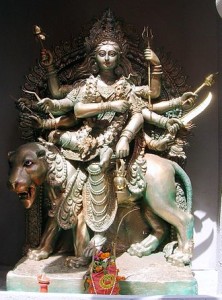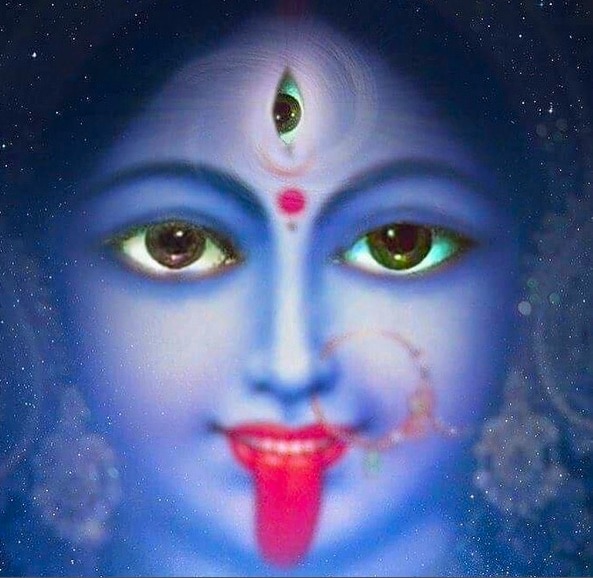
by Somya Devi | Oct 15, 2020 | Astrology, Conjunctions, Holy Days, Planets Changing Signs, Retrograde
New Moon and Navaratri
Tonight brings the dark Moon, coming towards a Moon-Sun alignment to begin a new Moon cycle on October 16th at 3:31 pm EDT, at the very end of sidereal Virgo (29°46’). This is also the start of the autumnal, Sharada or Maha Navaratri, which celebrates Goddess Durga and many forms of the goddess through on each of the first nine nights of the waxing Moon this month— October 16th through 24th in North America this year.
Lunar Cycle
Though the Sun and Moon align at the end of Virgo, they will move together into sidereal Libra only a few hours after the New Moon moment, thus beginning a lunar cycle with the Sun traveling through Libra. Libra energy is about balance. It is ruled by Venus, the planet of pleasure, harmony, and beauty. In a world that feels so imbalanced, our collective and individual energy will shift in ways that attempt to create greater balance, more compromise, and hopefully more harmony and beauty across the planet. The full Moon on October 31st will highlight Aries energy, Libra’s opposite, drawing us towards expressions of individual strength and will.
Sun Debilitated
The Sun is debilitated in Libra, because when we strive to compromise and take care of others we often do so at the expense of our own self-care. Remember that self-care is especially important this month when the Sun is at its weakest, and the seasons are changing from Pitta to Vata time across most of the northern hemisphere. In Ayurveda this seasonal junction is a good time to do some light cleansing but nothing that is too depleting as we move into vata time.
Mercury, Mars Retrograde
Mercury and Mars are still traveling in retrograde motion in Libra and Pisces, respectively. Mercury will station on November 3rd, election day in the U.S., sending his focused rays of attention and balance towards us. This could be favorable for bringing more rational and practical equilibrium into the political system. Mars will station and turn direct on November 11th, also directing some potent energy towards us, this time martial in nature which could stimulate some violence or fires, though not as drastic as we saw around his last station on October 3rd.
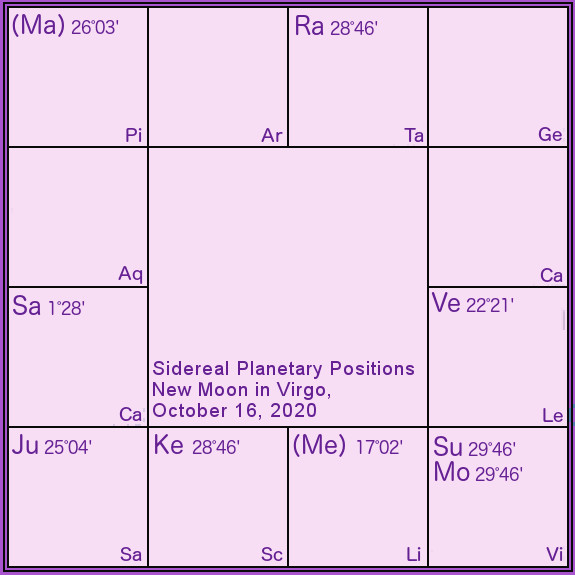
Chitra
This new Moon aligns with the Sun under Chitra nakshatra, “the brilliant.” This star-sign correlates with Spica, the brightest star in the sky, and bridges Virgo and Libra. It is ruled by Vishvakarma, the celestial architect. Moving from Virgo to Libra it combines both the energy of precision and perfection with that of beauty and grace. What are you trying to construct in the world that could use more architectural precision as well as beauty? This is a good time to call in this energy and channel it into any projects on your plate. Be careful that your inspiration does not lead to overindulgence under this intense nakshtra, whose animal symbol is the female tiger.
Maha Navaratri
The New Moon this month brings one of the largest Hindu festivals of the year, Maha Navaratri. Navaratri means “the nine nights,” and beginning with the first Moon phase after the dark Moon, the Goddess Devi is celebrated through many forms for the following nine nights and ten days. In North America Navaratri will be celebrated from October 16th through October 25th, with October 25th being the 10th day of Victory (an auspicious time for starting new endeavors, after 9 nights of worship). In some places Navaratri celebrates the goddess Durga in nine of her forms, while in other parts of India the festival commemorates Durga/Kali, Lakshmi, and Sarasvati for three nights each.
Devi is the creatrix, the warrioress, the nurturer, the purifyer, the protector. She can be found in the innocent and fertile maiden as well as the wise and learned crone. She is both the nurturing mother, and the one who gives “tough love.” The impassioned lover, the devoted bhakta, the disciplined yogini. We see Devi appear through us in innumerable manifestations. Through her many forms, she teaches us and offers us countless blessings–love, compassion, courage, learning, discipline, surrender, success, enlightenment, and bliss.
This festival is a time for honoring and celebrating the supreme feminine power in all her glory, and the many blessings she bestows upon us. Stay tuned for daily updates on how to connect with the many forms of the Goddess.

by Somya Devi | Sep 27, 2019 | Astrology, Events, Holy Days
Maha Navaratri 2019 is upon us! In this important Hindu holiday, we celebrate the Goddess through “the great nine nights” (nav = nine, ratri = night). This festival will run from September 29th through October 8th, the first ten days of this new lunar cycle. Goddess, Devi, Shakti, Durga, Divine Mother—the many names and forms all represent the dynamic and fluid feminine power that enlivens all of existence.
She is the creatrix, the warrioress, the nurturer, the purifyer, the protector. While she’s in the innocent and fertile maiden so is she the wise and learned crone. Both the nurturing mother, and the one who gives “tough love.” The impassioned lover, the devoted bhakta, the disciplined yogini. We see Goddess appear through us in innumerable manifestations. Through her many forms she teaches us and offers us countless blessings–love, compassion, courage, learning, discipline, surrender, success, enlightenment, and bliss. This festival is a time for celebrating the supreme feminine power in all her glory, and the many blessings she bestows upon us.
As with most Hindu celebrations, this festival correlates with the lunar calendar, and thus begins on the first day of the waxing Moon after the New Moon of September 28th. The celebration is through the “nine nights” of September 29th through October 7th, and into the tenth morning known as Vijayadashami, “the day of victory.” Worship during Navaratri is most generally dedicated to Goddess in the form of Durga, the demon-slayer, but there is much nuance and variation to practice and forms of celebration throughout India. Above all, Navaratri is a community celebration of the Divine Mother, and the love, abundance and protection she gives.
There are many Navaratri celebrations throughout the year, but the fall-time Navaratri is the most widely celebrated, and is thus called Maha Navaratri – “the great nine nights”. It correlates with the time of the harvest, a time to give thanks for the abundance of the year’s work. Grains and crops are often offered to Devi as part of the celebrations. Ritualistic worship (puja) typically occurs in homes and temples throughout the nine nights and into the tenth morning of celebration.
The Many Forms of Goddess
Durga-Lakshmi-Sarasvati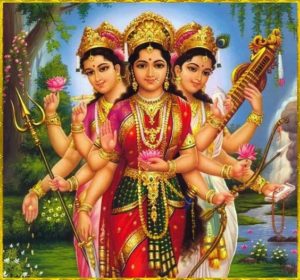
In Kerala and other places in India, the first three nights of worship are dedicated to Durga (the invincible), the next three to Lakshmi (Goddess of prosperity), and the final three to Sarasvati (Goddess of learning). Durga, also celebrated as her incarnation of Kali, helps us to destroy and remove the negative tendencies in our minds and hearts, freeing us from the obstructions to our spiritual and material pursuits. Lakshmi helps us to cultivate positive qualities like compassion and devotion, and leads us towards both spiritual and material prosperity. Sarasvati assists us in attaining knowledge and wisdom, through the illumination of our consciousness. She aids in awakening sattva, the quality of purity, and the flow of prana, the vital breath. After removing inner and outer obstacles and cultivating prosperity through virtuous qualities, our devotion, service, and practice help us to attain a state of peace, bliss, and oneness.
Sarasvati-Lakshmi-Kali/Durga
In the Kali Kula (Kali school of worship) in northeastern India, Sarasvati is worshiped on the first three nights, followed by Lakshmi on the next and then Kali/Durga on the last three. Sarasvati, Lakshmi, and Kali/Durga (Kali emerged from Durga) are also known as the consorts of Brahma, Vishnu, and Shiva. The Goddesses, therefore, provide the shakti to the cosmic processes of creation, preservation, and death (transformation), similar to their male counterparts. Consequently, worship in this manner is dedicated to the cycles of life and Mother nature, through birth, then sustenance, then death. Death is not a complete stop, but allows for the regeneration of energy into a new cycle once again.
9 Forms of Durga
Throughout India, the nine nights of Navaratri are often dedicated to 9 different incarnations of Durga, allowing the worship of many different aspects of Shakti in a gradual evolution. You can read the stories and significance of these 9 goddesses here, or a more a brief introduction, here:
“Daughter of the mountain”; creative energy, muladhara (root chakra), awakening; Awaken your connection with Goddess today or initiate a new venture, calling on Shailputri for new beginnings.
The ascetic; tapas, discipline, devotion, strength, wisdom, creative abundance; Good day for fasting and meditation, connection with svadhistana (sacral chakra).
Warrioress; protection, courage, grace, manipura (solar plexus); Destroy your internal obstacles by offering them to Chandraghanta.
Creatrix of the “cosmic egg”; strength, health, happiness, success, relationships; Connect with the vital Sun energy and the anahata (heart chakra) today.
“Mother of Skanda/Kartikeya”; motherly love, nourishment, protection, purity; Call on divine truth through the vishuddha (throat chakra), invoking Skandamata to lead you towards victory.
Warrioress who destroyed Mahishasura (the buffalo demon); victory, devotion, strength, removing obstacles; Meditate on these qualities of Goddess through the ajna chakra (third-eye) today.
“Dark/black night,” representing a fierce form of Durga/Kali; darkness, death, surrender, dissolution of pain; Connecting with the sahasrara (crown chakra), remember that Divine Mother offers love, compassion, and many blessings even in hard times. Even in the midst of apparent darkness, and helps us to go beyond the boundaries of the material body-mind and connect with spirit.
“Great white goddess”; detachment, purification, renewal, protection, virtue; Through detachment and devotion, we emerge purified, shining and radiant after surrendering in the dark night. Rejuvenative herbs and foods are good today.
Goddess of “siddhis”; magical, spiritual or mystic powers and blessings, fulfillment of desires, devotion, divine union; Invite Goddess to reveal her presence to you everywhere and in every moment.
Personal Practice Ideas for Navaratri
If possible, it is great to reduce our workload and gather with community at local temples or places of worship. We can also create a little time and space at home and conduct some personal practices to celebrate Goddess energy. Dive into your own heart to connect with the inner Goddess in the ways that resonate most with you! Here are some ideas to do at home or with a group throughout the nine nights of Navaratri:
Altar
Create a sacred space, a Durga altar, or a Goddess altar. Even if you already have one, you can refresh it in some way or rearrange it specifically for Navaratri. Include images or statues of the Goddess(es) you have a relationship with. This could be according to one of the groups of forms above.
Invocation
Even if you don’t have much time, dedicate at least a few minutes each day to connecting with the Divine Mother in front of your altar, calling her energy into your life and being.
Journal
Write in your journal about what qualities of Goddess you perceive and connect with. What aspects would you like to strengthen or to cultivate more deeply? Write any and all prayers and offer them to the form of Goddess that appeals to you.
Light
Offer light to illuminate Goddess’s power, helping her to shine more brightly into the world and your life. You can light a candle by the altar and keep it burning when you’re at home. You can even keep an electronic tealight on symbolically when you are away.
Flowers/Grains
Offer flowers or grains (even a small dish of dried rice) to celebrate Devi in the form of mother nature, fertility, the abundance of the harvest, and the cycle of life.
Offerings
Offer incense, bells, water, or food if you feel called, by placing it on the altar, or mentally offering it to Goddess throughout the day. You can also offer something symbolic of your own work or practice, whatever you have been cultivating for harvest through the year. In offering this you surrender the fruits of your efforts to the Divine Mother.
Fasting
Some people choose to fast in some variation, if this is something you have practiced before. This might include fasting during the day, fasting with only milk or fruit, or abstaining from alcohol and non-vegetarian foods during Navaratri.
Chanting
Chanting the Devi Mahatmyam, a verse to the Goddess, is a common practice during the nine-night festival. You can also chant another Goddess mantra or songs that are special to you and your relationship with Devi.
Jai Ma Durga!
Personal Vedic Astrology readings and forecasts are available Here.
Did you like Maha Navaratri 2019? Please Like, Comment and Share!
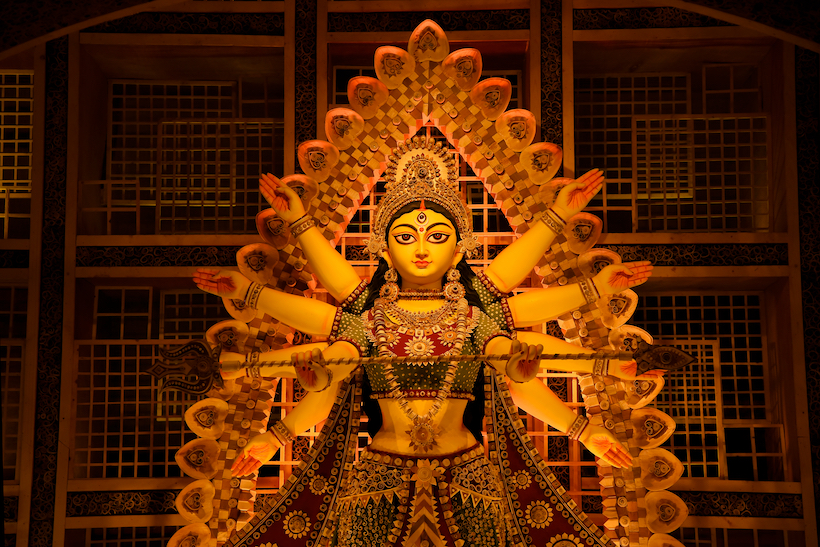
by Somya Devi | Sep 27, 2019 | Astrology, Conjunctions, Events, Holy Days, Planets Changing Signs
Tonight brings a dark Moon as the Moon joins the Sun in sidereal Virgo. Exact New Moon in Virgo will be at 11:26 am PT on Saturday, September 28th. This begins a Virgo cycle that will help us to connect with the earth, the feminine, and draw ourselves more inward as we enter the season of the Sun’s decent in the northern hemisphere.
Virgo Cycle
We’ve just passed the equinox on September 23rd, the time where night and day are of equal lengths, and we are now entering the yin season where the hours of darkness will exceed the hours of light. This first full lunar cycle begins in Virgo, a feminine earth sign, that encourages us to ground out some of the activity of summer and turn inwards as we come upon this darker season.
Virgo is also ruled by Mercury, the planet of the intellect, which will get us thinking about practicality and logistics this month. Have you planned your store for winter, getting together everything you need and tying up loose ends in the world before your period of inward attention and maybe even hybernation? Mercury is still technically joining the Sun and Moon in Virgo as we begin this cycle, but will be passing into Libra the next day. Venus and Mars also join in Virgo now, making our nights especially dark as these three stay close to the sun and only Jupiter and Saturn are visible. Venus remains debilitated in Virgo for just a few more days, until October 3rd.
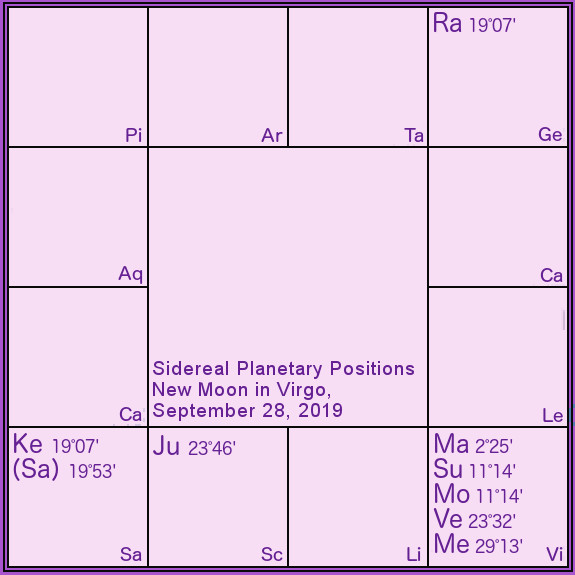
Hasta
This New Moon occurs with Sun and Moon in Hasta nakshatra, the sign of the hand. Hasta is a place that allows us to hone our skills, both manual and intellectual. It offers us a “craftiness,” whether literal, or of mind. This is a good time for getting into any hands-on work that requires dexterity, as well as for business dealings or other organization that requires tact and skill. Hasta is ruled by Savitar, the Sun God, while also linked to the Moon’s influence, and its animal is the female buffalo.
Maha Navaratri
The New Moon this month brings one of the largest Hindu festivals of the year, Maha Navaratri. Navaratri means “the nine nights,” and beginning with the first Moon phase after the dark Moon, the Goddess Devi is celebrated through many forms for the following nine nights and ten days. In North America Navaratri will be celebrated from September 29th through October 8th, with October 8th being the 10th day of Victory (an auspicious time for starting new endeavors, after 9 nights of worship). In some places Navaratri celebrates the goddess Durga in nine of her forms, while in other parts of India the festival commemorates Durga/Kali, Lakshmi, and Sarasvati for three nights each.
Devi is the creatrix, the warrioress, the nurturer, the purifyer, the protector. She can be found in the innocent and fertile maiden as well as the wise and learned crone. She is both the nurturing mother, and the one who gives “tough love.” The impassioned lover, the devoted bhakta, the disciplined yogini. We see Devi appear through us in innumerable manifestations. Through her many forms, she teaches us and offers us countless blessings–love, compassion, courage, learning, discipline, surrender, success, enlightenment, and bliss.
This festival is a time for honoring and celebrating the supreme feminine power in all her glory, and the many blessings she bestows upon us. Read more about Maha Navaratri 2019 here, and stay tuned for daily updates on how to connect with the many forms of the Goddess.
Kala Sarpa & Nodal Influences
This year’s festival could churn up even more internal difficulties than usual … offer them to the Goddess! We are currently under a Kala Sarpa cycle, with all planets to one side of the Rahu-Ketu axis, and will be in this alignment until October 6th. This can bring up more shadow energy and sticky spots than usual, especially if you are running a Rahu-Ketu dasha or have these planets prominently in your chart. It’s all the more reason to join the festivities and offer worship or some kind of spiritual practice during these days.
The good news on the nodal front — Saturn and Ketu will finally be separating a bit, and will leave their 1-degree proximity on October 1st! With Mean Node calculations, Ketu and Saturn have been joined within one degree of each other since April 25th! This will begin to slowly take some pressure off in the area of your life shown by Sagittarius, or those ruled by Saturn.
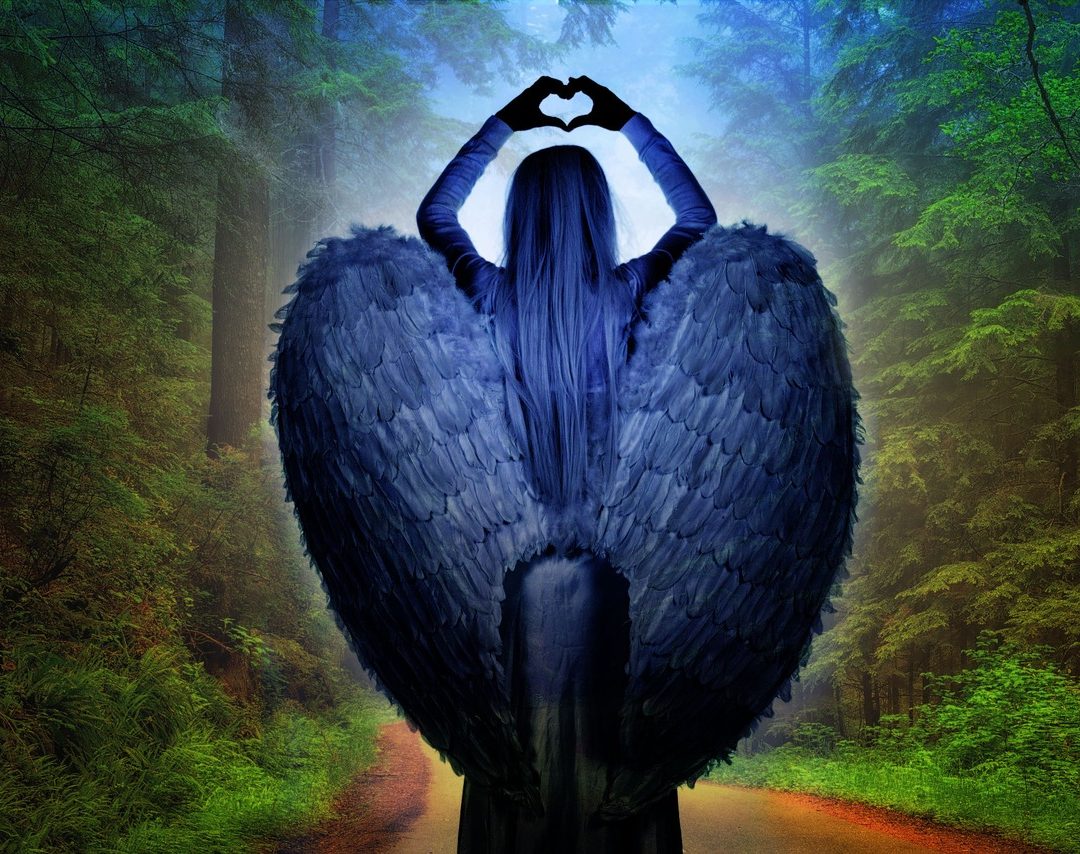
by Somya Devi | Oct 4, 2018 | Astrology, Conjunctions, Planets Changing Signs, Retrograde
I love this time of year. Having passed the equinox on September 22nd, the dark of night comes noticeably earlier. The air temperature, moisture and barometric pressure have taken a definite turn. And the instinct to nest and cozy up at home is on.
From now through the spring equinox, we in the northern hemisphere are in the yin portion of the year, where nighttime exceeds day, and our energy is more naturally directed inward. With fewer hours to be out in the world acting, there is more time to spend still and being. This is a time for the mystic feminine to thrive.
Monday, October 8th will bring a dark Moon night to start the first lunar cycle fully in the yin season. At 8:47 pm PDT, the Sun and Moon align at 21° sidereal Virgo, in Hasta nakshatra. This is a great way to start a season of grounding into ourselves, nurturing our feminine essence and our creative potential. Fittingly, this cycle brings with it the Navaratri festival, the nine nights of celebrating the goddess in her many forms.

Virgo Cycle
Virgo is the feminine earth sign ruled by Mercury. In Sanskrit, Virgo is Kanya, literally the “girl” or the “maiden.” This sign relates to fertility, as well as a pure feminine being. Virgo’s nature compels us to try to take care of everyone and all the details, and as the Sun moves into Libra, his sign of debilitation, later this month, we must be careful not to overexert ourselves and become depleted.
With exalted Mars and Ketu still transiting the fifth from Virgo, this month will call us to explore our creative potential, and what fears and resistance we may hold around that. With Saturn transiting the fourth and Mercury, Jupiter and Venus in the second, there is a lot of energy going towards the home and family this month.
Hasta
Within Virgo, the Sun and Moon align in Hasta nakshatra to begin this lunar cycle. Hasta is “the hand,” and implies all things crafty. We find potential to take up any number of manual skills or projects this month, as well as utilizing the intellect (Mercury) to craft our situations towards our goals. Ruled by the Moon, this star brings forth our feminine nature and guides us from the heart, so be sure to listen in the stillness of the dark Moon nights.
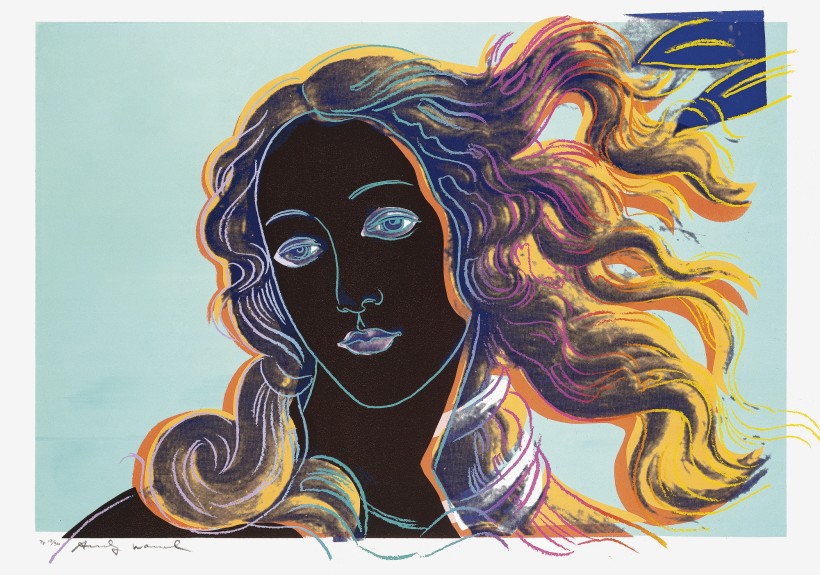
I just love this Warhol image for Retrograde Venus!
Venus
Venus has come to a stop and is entering retrograde motion on October 5th. For all of us, this will be an opportunity to slow down and retrace the steps we have taken towards happiness, as well as look closely at our relationships and our styles of relating. It may feel like a slow-down our happiness or relationships are challenged right now, but every challenge is an opportunity for our own self-development. It’s a good time to work on developing new skills in relating, whether by a communication class, couples’ workshop, or any personal development coaching work.
You may also experience things slowing down in the areas of your life ruled by Venus in your natal chart, different for each Vedic rising sign.
Jupiter
For a few more days, Jupiter and Venus are joined in sidereal Libra, but Jupiter will complete his transit here and move into sidereal Scorpio on October 11th. This next Jupiter transit will last through November 4, 2019. Jupiter in Scorpio can expand our opportunity to connect with the mystic. The depth of self-inquiry and self-development practices will grow during this period. Passions can be heightened and intensified, and our philosophical warrior will be strong.
 Navaratri
Navaratri
The nine nights of the goddess is a festival celebrated by Hindus worldwide. Navaratri will begin on the first night of the waxing Moon this lunar cycle, starting October 9th. On each of nine consecutive nights (nav + ratri), we can worship the goddess, Devi, through her many forms. Most notably this festival celebrates the goddess Durga in nine of her forms, but in other parts of India the festival commemorates Durga/Kali, Lakshmi, and Sarasvati for three nights each.
Devi is the creatrix, the warrioress, the nurturer, the purifyer, the protector. She can be found in the innocent and fertile maiden as well as the wise and learned crone. She is both the nurturing mother, and the one who gives “tough love.” The impassioned lover, the devoted bhakta, the disciplined yogini. We see Devi appear through us in innumerable manifestations. Through her many forms, she teaches us and offers us countless blessings–love, compassion, courage, learning, discipline, surrender, success, enlightenment, and bliss.
This festival is a time for honoring and celebrating the supreme feminine power in all her glory, and the many blessings she bestows upon us. Stay tuned for daily updates on how to connect with the many forms of the Goddess.

by Somya Devi | Sep 20, 2017 | Astrology, Events, Holy Days
Maha Navaratri 2017 begins today! In this important Hindu holiday, we celebrate the Goddess through “the great nine nights” (nav = nine, ratri = night). This festival will run through September 30th, the first ten days of this new lunar cycle. Goddess, Devi, Shakti, Durga, Divine Mother—the many names and forms all represent the dynamic and fluid feminine power that enlivens all of existence.
She is the creatrix, the warrioress, the nurturer, the purifyer, the protector. While she’s in the innocent and fertile maiden so is she the wise and learned crone. Both the nurturing mother, and the one who gives “tough love.” The impassioned lover, the devoted bhakta, the disciplined yogini. We see Goddess appear through us in innumerable manifestations. Through her many forms she teaches us and offers us countless blessings–love, compassion, courage, learning, discipline, surrender, success, enlightenment, and bliss. This festival is a time for celebrating the supreme feminine power in all her glory, and the many blessings she bestows upon us.
As with most Hindu celebrations, this festival correlates with the lunar calendar, and thus begins on the first day of the waxing Moon after the New Moon of September 19th. The celebration is through the “nine nights” of 21st through 29th, and into the eleventh morning known as Vijayadashami, “the day of victory,” on September 30th in some places (because of the way the lunar phases correlate with the solar days… Check the Vedic panchanga for your city to see the exact dates for Navaratri where you are.). Worship during Navaratri is most generally dedicated to Goddess in the form of Durga, the demon-slayer, but there is much nuance and variation to practice and forms of celebration throughout India. Above all, Navaratri is a community celebration of the Divine Mother, and the love, abundance and protection she gives.
There are many Navaratri celebrations throughout the year, but the fall-time Navaratri is the most widely celebrated, and is thus called Maha Navaratri – “the great nine nights”. It correlates with the time of the harvest, a time to give thanks for the abundance of the year’s work. Grains and crops are often offered to Devi as part of the celebrations. Ritualistic worship (puja) typically occurs in homes and temples throughout the nine nights and into the tenth morning of celebration.
The Many Forms of Goddess
Durga-Lakshmi-Sarasvati
In Kerala and other places in India, the first three nights of worship are dedicated to Durga (the invincible), the next three to Lakshmi (Goddess of prosperity), and the final three to Sarasvati (Goddess of learning). Durga, also celebrated as her incarnation of Kali, helps us to destroy and remove the negative tendencies in our minds and hearts, freeing us from the obstructions to our spiritual and material pursuits. Lakshmi helps us to cultivate positive qualities like compassion and devotion, and leads us towards both spiritual and material prosperity. Sarasvati assists us in attaining knowledge and wisdom, through the illumination of our consciousness. She aids in awakening sattva, the quality of purity, and the flow of prana, the vital breath. After removing inner and outer obstacles and cultivating prosperity through virtuous qualities, our devotion, service, and practice help us to attain a state of peace, bliss, and oneness.
Sarasvati-Lakshmi-Kali/Durga
In the Kali Kula (Kali school of worship) in northeastern India, Sarasvati is worshiped on the first three nights, followed by Lakshmi on the next and then Kali/Durga on the last three. Sarasvati, Lakshmi, and Kali/Durga (Kali emerged from Durga) are also known as the consorts of Brahma, Vishnu, and Shiva. The Goddesses, therefore, provide the shakti to the cosmic processes of creation, preservation, and death (transformation), similar to their male counterparts. Consequently, worship in this manner is dedicated to the cycles of life and Mother nature, through birth, then sustenance, then death. Death is not a complete stop, but allows for the regeneration of energy into a new cycle once again.
9 Forms of Durga
Throughout India, the nine nights of Navaratri are often dedicated to 9 different incarnations of Durga, allowing the worship of many different aspects of Shakti in a gradual evolution. You can read the stories and significance of these 9 goddesses here (or click on Goddess name below), or a more a brief introduction, here:
“Daughter of the mountain”; creative energy, muladhara (root chakra), awakening; Awaken your connection with Goddess today or initiate a new venture, calling on Shailputri for new beginnings.
The ascetic; tapas, discipline, devotion, strength, wisdom, creative abundance; Good day for fasting and meditation, connection with svadhistana (sacral chakra).
Warrioress; protection, courage, grace, manipura (solar plexus); Destroy your internal obstacles by offering them to Chandraghanta.
4. Kushmanda (September 23rd)
Creatrix of the “cosmic egg”; strength, health, happiness, success, relationships; Connect with the vital Sun energy and the anahata (heart chakra) today.
“Mother of Skanda/Kartikeya”; motherly love, nourishment, protection, purity; Call on divine truth through the vishuddha (throat chakra), invoking Skandamata to lead you towards victory.
6. Katyayani (September 25th)
Warrioress who destroyed Mahishasura (the buffalo demon); victory, devotion, strength, removing obstacles; Meditate on these qualities of Goddess through the ajna chakra (third-eye) today.
7. Kalaratri (September 26th)
“Dark/black night,” representing a fierce form of Durga/Kali; darkness, death, surrender, dissolution of pain; Connecting with the sahasrara (crown chakra), remember that Divine Mother offers love, compassion, and many blessings even in hard times. Even in the midst of apparent darkness, and helps us to go beyond the boundaries of the material body-mind and connect with spirit.
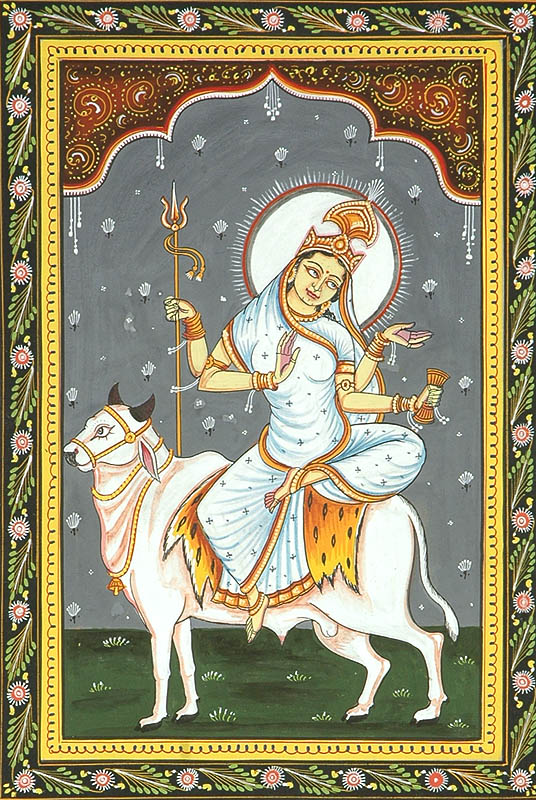 8. Mahagauri (September 27th-28th)
8. Mahagauri (September 27th-28th)
“Great white goddess”; detachment, purification, renewal, protection, virtue; Through detachment and devotion, we emerge purified, shining and radiant after surrendering in the dark night. Rejuvenative herbs and foods are good today.
Goddess of “siddhis”; magical, spiritual or mystic powers and blessings, fulfillment of desires, devotion, divine union; Invite Goddess to reveal her presence to you everywhere and in every moment.
Personal Practice Ideas for Navaratri
If possible, it is great to reduce our workload and gather with community at local temples or places of worship. We can also create a little time and space at home and conduct some personal practices to celebrate Goddess energy. Dive into your own heart to connect with the inner Goddess in the ways that resonate most with you! Here are some ideas to do at home or with a group throughout the nine nights of Navaratri:
Altar
Create a sacred space, a Durga altar, or a Goddess altar. Even if you already have one, you can refresh it in some way or rearrange it specifically for Navaratri. Include images or statues of the Goddess(es) you have a relationship with. This could be according to one of the groups of forms above.
Invocation
Even if you don’t have much time, dedicate at least a few minutes each day to connecting with the Divine Mother in front of your altar, calling her energy into your life and being.
Journal
Write in your journal about what qualities of Goddess you perceive and connect with. What aspects would you like to strengthen or to cultivate more deeply? Write any and all prayers and offer them to the form of Goddess that appeals to you.
Light
Offer light to illuminate Goddess’s power, helping her to shine more brightly into the world and your life. You can light a candle by the altar and keep it burning when you’re at home. You can even keep an electronic tealight on symbolically when you are away.
Flowers/Grains
Offer flowers or grains (even a small dish of dried rice) to celebrate Devi in the form of mother nature, fertility, the abundance of the harvest, and the cycle of life.
Offerings
Offer incense, bells, water, or food if you feel called, by placing it on the altar, or mentally offering it to Goddess throughout the day. You can also offer something symbolic of your own work or practice, whatever you have been cultivating for harvest through the year. In offering this you surrender the fruits of your efforts to the Divine Mother.
Fasting
Some people choose to fast in some variation, if this is something you have practiced before. This might include fasting during the day, fasting with only milk or fruit, or abstaining from alcohol and non-vegetarian foods during Navaratri.
Chanting
Chanting the Devi Mahatmyam, a verse to the Goddess, is a common practice during the nine-night festival. You can also chant another Goddess mantra or songs that are special to you and your relationship with Devi.
Jai Ma Durga!
Personal Vedic Astrology readings and forecasts are available Here.
Did you like Maha Navaratri 2017? Please Like, Comment and Share!
Save
Save
Save
Save
Save




